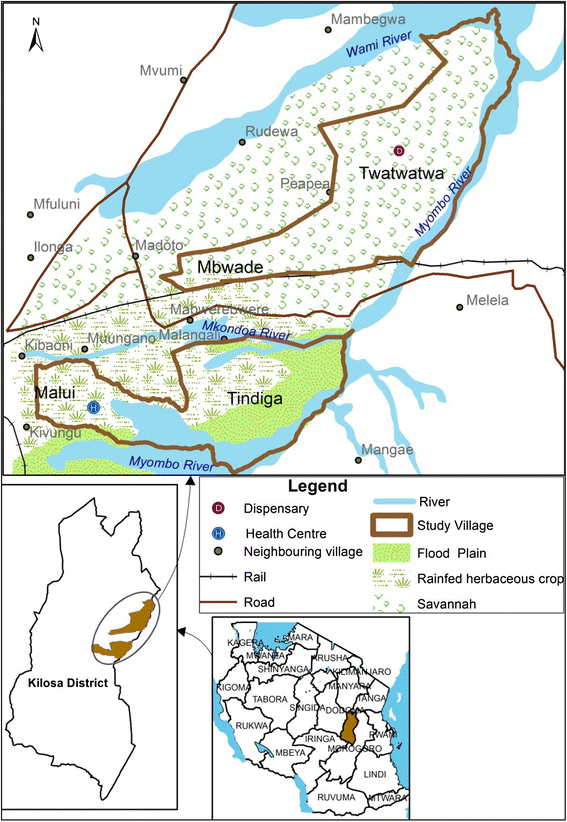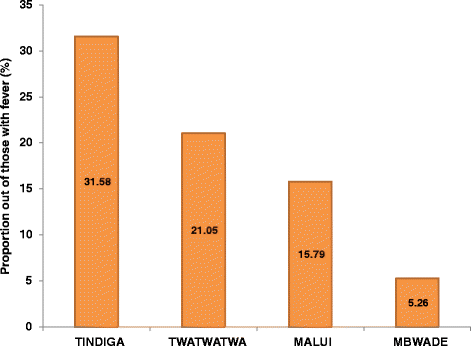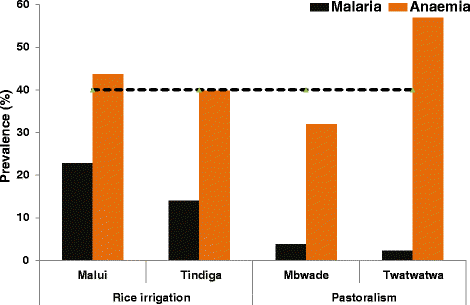Malaria, anaemia and nutritional status among schoolchildren in relation to ecosystems, livelihoods and health systems in Kilosa District in central Tanzania
- PMID: 26082157
- PMCID: PMC4469328
- DOI: 10.1186/s12889-015-1932-x
Malaria, anaemia and nutritional status among schoolchildren in relation to ecosystems, livelihoods and health systems in Kilosa District in central Tanzania
Abstract
Background: Malaria prevalence and transmission intensity in Tanzania is heterogeneous with spatial and temporal variations between geographical areas and ecological systems. The objective of this study was to determine the prevalence of malaria, anaemia and nutritional status in relation to livelihoods, ecosystem and health systems in Kilosa District in central Tanzania.
Methods: This study was conducted in four villages, two characterised by rice irrigation ecosystem and the other two by dry savannah ecosystem and pastoral livelihoods. In each ecosystem, one of the villages had a healthcare facility. Schoolchildren were screened for malaria infection using malaria rapid diagnostic test (mRDT) and microscopy and they were assessed for their anaemia and nutritional statuses.
Results: A total of 1,019 school children (age = 4-16 years) were screened for malaria infection. The overall prevalence of Plasmodium falciparum infection was 10.6% and 4.5% by mRDT and microscopy, respectively. Children from pastoral villages had lower (2.9%) prevalence of malaria than their counterparts (18.2%) in the rice irrigation villages. A significantly high risk of malaria was observed among children in rice irrigation than in the pastoral ecosystem (OR: 0.13; 95%CI 0.07, 0.23). Children living in areas with health care facilities had a low odd of malaria infection by 45% (OR: 0.55; 95% CI = 0.35, 0.86). Overall, the prevalence of anaemia in the district was 43.4% (n = 775); and 58.3% of those with severe anaemia were among children from the pastoral villages. Anaemia was significantly higher among children not using mosquito nets (p = 0.049); and among those with malaria infection (p <0.001). The majority (96%) of the children had Body Mass Index less than 18.5 kg/m(2) which indicate high proportion of underweight.
Conclusion: There are significant variations in the risk of acquiring malaria infection between different ecosystems and livelihoods. These findings suggest that malaria control programmes must take into account ecosystems and livelihoods of the targeted population through an integrated management of malaria and nutrition approach.
Figures



Similar articles
-
Comparison of fine-scale malaria strata derived from population survey data collected using RDTs, microscopy and qPCR in South-Eastern Tanzania.Malar J. 2024 Dec 18;23(1):376. doi: 10.1186/s12936-024-05191-8. Malar J. 2024. PMID: 39696325 Free PMC article.
-
Malaria among rice farming communities in Kilangali village, Kilosa district, Central Tanzania: prevalence, intensity and associated factors.Infect Dis Poverty. 2017 Jul 5;6(1):101. doi: 10.1186/s40249-017-0315-1. Infect Dis Poverty. 2017. PMID: 28676077 Free PMC article.
-
Defining the optimum strategy for identifying adults and children with coeliac disease: systematic review and economic modelling.Health Technol Assess. 2022 Oct;26(44):1-310. doi: 10.3310/ZUCE8371. Health Technol Assess. 2022. PMID: 36321689 Free PMC article.
-
Impact of residual disease as a prognostic factor for survival in women with advanced epithelial ovarian cancer after primary surgery.Cochrane Database Syst Rev. 2022 Sep 26;9(9):CD015048. doi: 10.1002/14651858.CD015048.pub2. Cochrane Database Syst Rev. 2022. PMID: 36161421 Free PMC article. Review.
-
Depressing time: Waiting, melancholia, and the psychoanalytic practice of care.In: Kirtsoglou E, Simpson B, editors. The Time of Anthropology: Studies of Contemporary Chronopolitics. Abingdon: Routledge; 2020. Chapter 5. In: Kirtsoglou E, Simpson B, editors. The Time of Anthropology: Studies of Contemporary Chronopolitics. Abingdon: Routledge; 2020. Chapter 5. PMID: 36137063 Free Books & Documents. Review.
Cited by
-
Evaluating malaria prevalence and land cover across varying transmission intensity in Tanzania using a cross-sectional survey of school-aged children.Malar J. 2022 Mar 9;21(1):80. doi: 10.1186/s12936-022-04107-8. Malar J. 2022. PMID: 35264152 Free PMC article.
-
Child Health and Infection with Low Density (CHILD) malaria: a protocol for a randomised controlled trial to assess the long-term health and socioeconomic impacts of testing and treating low-density malaria infection among children in Tanzania.BMJ Open. 2024 Mar 27;14(3):e082227. doi: 10.1136/bmjopen-2023-082227. BMJ Open. 2024. PMID: 38538037 Free PMC article.
-
Prevalence of asymptomatic malaria, submicroscopic parasitaemia and anaemia in Korogwe District, north-eastern Tanzania.Malar J. 2021 Oct 29;20(1):424. doi: 10.1186/s12936-021-03952-3. Malar J. 2021. PMID: 34715886 Free PMC article.
-
Proximity of Residence to Irrigation Determines Malaria Risk and Anopheles Abundance at an Irrigated Agroecosystem in Malawi.Am J Trop Med Hyg. 2021 Oct 18;106(1):283-292. doi: 10.4269/ajtmh.21-0390. Am J Trop Med Hyg. 2021. PMID: 34662858 Free PMC article.
-
Relationship between the Usage of Long-Lasting Insecticide-Treated Bed Nets (LLITNs) and Malaria Prevalence among School-Age Children in Southwestern Nigeria.J Environ Public Health. 2021 Mar 25;2021:8821397. doi: 10.1155/2021/8821397. eCollection 2021. J Environ Public Health. 2021. PMID: 33833812 Free PMC article.
References
-
- Mboera LEG. Fifty Years of Health Research in Tanzania (1949–1999). Annotated Bibliography. 2000.
Publication types
MeSH terms
LinkOut - more resources
Full Text Sources
Other Literature Sources
Medical

